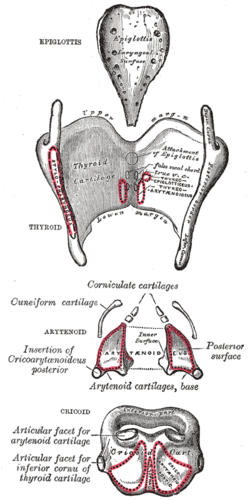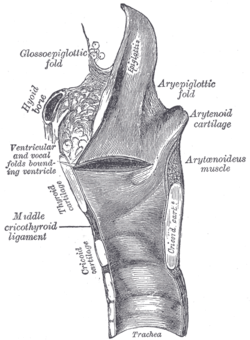Arytenoid cartilage
The arytenoid (/ærɪˈtiːnɔɪd/)[1] cartilages are a pair of small three-sided pyramids which form part of the larynx, to which the vocal folds (vocal cords) are attached. These allow and aid in the vocal cords' movement.
| Arytenoid cartilage | |
|---|---|
 The cartilages of the larynx seen from behind | |
| Details | |
| Precursor | 4th and 6th pharyngeal arch |
| Identifiers | |
| Latin | Cartilagines arytenoideae |
| MeSH | D001193 |
| TA | A06.2.04.001 |
| FMA | 55109 |
| Anatomical terminology | |
Each is pyramidal or ladle-shaped in form (arytenoid comes from Ancient Greek ἀρύταινα arytaina meaning "ladle" and εἶδος eidos, meaning "form"),[2] and has three surfaces, a base, and an apex.
Structure
Surfaces
The posterior surface is triangular, smooth, concave, and gives attachment to the arytenoid muscle and transversus.
The antero-lateral surface is somewhat convex and rough. On it, near the apex of the cartilage, is a rounded elevation (colliculus) from which a ridge (crista arcuata) curves at first backward and then downward and forward to the vocal process. The lower part of this crest intervenes between two depressions or foveæ, an upper, triangular, and a lower oblong in shape; the latter gives attachment to the vocalis muscle.
The medial surface is narrow, smooth, and flattened, covered by mucous membrane, and forms the lateral boundary of the intercartilaginous part of the rima glottidis.
Base and apex
The base of each cartilage is broad, and on it is a concave smooth surface, for articulation with the cricoid cartilage.
- Its lateral angle is called the muscular process
- Its anterior angle is called the vocal process
The apex of each cartilage is pointed, curved backward and medialward, and surmounted by a small conical, cartilaginous nodule, the corniculate cartilage.
Function
They allow the vocal folds to be tensed, relaxed, or approximated.
The arytenoids articulate with the supero-lateral parts of the cricoid cartilage lamina, forming the cricoarytenoid joints at which they can come together, move apart, tilt anteriorly or posteriorly, and rotate.
Additional images
 Sagittal section of the larynx and upper part of the trachea.
Sagittal section of the larynx and upper part of the trachea. The entrance to the larynx, viewed from behind.
The entrance to the larynx, viewed from behind. Muscles of the larynx, seen from above.
Muscles of the larynx, seen from above.- Arytenoid cartilage
- Arytenoid cartilage
References
- Murry, James A. H. (1888). A New English Dictionary on a Historical Basis. Oxford: Clarendon Press. p. 477.
- Farlex dictionary: arytenoid cartilage Citing: Mosby's Medical Dictionary, 8th edition.
- This article incorporates text in the public domain from page 1075 of the 20th edition of Gray's Anatomy (1918)